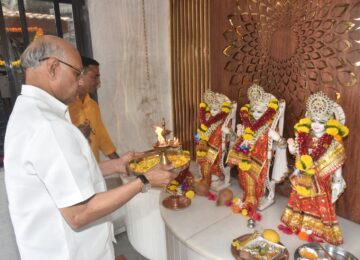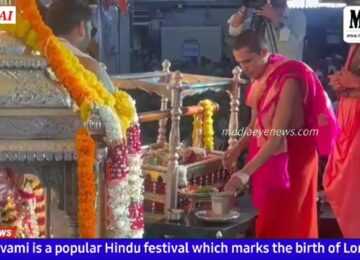By Anupama Nair
Mumbai, May 3
As a woman, freedom and empowerment of women is a topic close to my heart. I remember Rousseau’s famous statement during the French Revolution, “man is born free, but he is everywhere in chains”. But for men a lot changed but what has not changed is for women. So, we can correctly say “women are born free, but she is everywhere in chains”. Even in the 21st century there is not much change anywhere in the world. She is a victim of domestic violence, rape and many horrors. The US has the most cases of domestic violence in the world. To add to misery, religions play a huge part in their condition.
In many parts of the world, women were thought as witches and burnt alive. The book “Scarlet Letter” by Nathaniel Hawthorne shows the condition of women in colonial and Puritan America. Boston was the place where most women were burnt as witches. In ancient India, the condition was little better, but it deteriorated with time and even education was denied to her.
What is women empowerment? In simple terms women's empowerment is the process of empowering women. It may be defined as including accepting women's viewpoints or making an effort to seek them, raising the condition of women through education, awareness, literacy, and training. Women's empowerment trains and allows women to make life-determining decisions through the different problems in society. They may have the opportunity to redefine gender roles or other such roles, which in turn may allow them more freedom to pursue desired goals.
Women's empowerment has become a significant topic of discussion in development and economics. By economic empowerment I mean women is allowed to control and benefit from resources, assets, and income. It also aids the ability to manage and risk and improve well-being of the women. The more comprehensive concept of concerns people of any gender empowerment, stressing the distinction between biological and gender as a role.
In order to preach the eternal principles of Dharma and righteousness there have been numerous women saints, scholars, rulers and freedom fighters who have shone as a beacon of hope and courage under great odds to inspire millions of women all over the world. Often women fought wars to protect their land, homes, ideals or families, the same reasons men did. Today women still take up arms against enemies, remember the women of the past and present and let us keep their spirits alive within our hearts!
When I speak about India to a foreigner and ask what they think about India, the reply I get is “India is a vibrant country with vibrant people, culture, hot and spicy food, colorful textiles, hot and cold weather together. It is these intricacies that fascinate a first-time visitor of India. Do you know, India is home to great women from each and every corner of the great country “ from fighting against Islamic invaders to the British to fight for Independence and lastly those brave mothers, who encouraged their children to fight for Swaraj. Some of these queens are famous for their beauty too.
Let me talk about each one of those great women in detail.
Maharani Samyukta:
Samyukta, is a character in the medieval Indian Medieval Romance “Pritviraj Raso”. She was the daughter of Jaichand, the King of Kannauj and the wife of Prithviraj Chauhan. She is a popular figure of romance and chivalry from the folklore of medieval India. The love between Prithviraj and Samyukta is one of India's most popular medieval romances, immortalized in Chand Bardoi’s epic, “Pritviraj Raso”.
Prithviraj was a great conqueror and his kingdom at the greatest extent included vast regions of northern Bharat. His name and fame spread across the subcontinent and Afghanistan as well. Many lesser kings were envious and wary of his power, particularly Raja Jaichand of Kannauj. Jaichand's daughter, Samyukta, was known for her bewitching beauty. She is said to have fallen in love with Prithviraj as his reputation dazzled her. She desired nobody but him. Prithviraj had heard about Samyukta's loveliness and fell in love with her.
Prithviraj and Jaichand were rivals and on finding out about the affair, Raja Jaichand was outraged that a romance had been budding behind his back. Jaichand decided to insult Prithviraj and arranged a swayamvar (wedding) for his daughter in 1185 AD. He invited royal princes from far and wide to the ceremony, each and every eligible prince and king, except Prithviraj. He then commissioned a clay statue of Prithviraj, which served as a dwarpal or doorman to Jaichand's court.
Prithviraj Chauhan, on hearing about the impending swayamvar, devised a plan to elope with Samyukta. On the day of the ceremony, Samyukta walked through the court holding the ceremonial garland, and ignored the gazes of her ardent suitors. She passed through the door and put the garland around the neck of Prithviraj's statue, declaring him to be her husband. Prithiviraj, who meanwhile was hiding behind the statue, caught Samyukta up in his arms, set her on his horse, and whisked her away to Delhi, enraging Raja Jaichand.
Mira Bai
Meera, also known as Mirabai (1498–1546), was a 16th-century saint, poet and devotee of Krishna. She is a celebrated Bhakti saint, particularly in the North Indian Hindu tradition. Mirabai was born into a Rajasthani royal family. Mira then spent her childhood in Merta, Rajasthan. She is confirmed to and was widely known and a cherished figure in the Bhakti movement by about 1600 AD. Most legends about Meera mention her fearless disregard for social and family conventions, her devotion to Bhagwan Krishna, her treating Krishna as her husband and being persecuted by her in-laws for her religious devotion. She has been the subject of numerous folk tales which are inconsistent or widely different in details. Millions of devotional hymns in passionate praise of Bhagwan Krishna are attributed to Mirabai in the Indian tradition. These, hymns are commonly known as bhajans, and are popular across India. Hindu temples, in Chittorgarh fort, are dedicated to Mira Bai's memory. Legends about Meera's life, of contested authenticity, have been the subject of movies, comic strips and other popular literature in modern times.
Rani Padmini
If beauty and brains were combined in one person, it would be Rani Padmini, also known as Padmavati, as beautiful as Greek queen Helen of Troy. Rani Padmavati was a legendary 13th–14th century queen of Mewar (present-day Rajasthan). Several 16th-century texts mention her, of which the earliest source is Padmavat a poem written by Malik Muhammad Jayasi in 1540 AD. There are many stories about Rani Padmavati and historians questions the truthfulness of the story
Padmavati was an exceptionally beautiful princess of the Singhal (Sri Lanka). Rana Ratan Singh, the Rajput ruler of the kingdom of Chittor, heard about her beauty from a talking parrot named Hiraman. After an adventurous quest, he won her hand in marriage and brought her to Chittor. Ratan Singh was captured and imprisoned by Allaudin Khilji, the Sultan of Delhi. While Ratan Singh was in prison, the cruel Sultan made a pact with Padmavati. With the help of loyal soldiers, Ratan Singh was released soon. In a duel with Alauddin Khilji he was killed. Khilji laid siege to Chittor to obtain the beautiful Padmavati. Facing an imminent defeat against Khilji, before Chittor was captured, she and her companions committed Jauhar (self-immolation), thereby defeating Khilji's aim and protecting their honor. Other written and oral versions of her life exist in Hindu and Jain traditions. There are many versions from the Sufi poet, Jayasi's version. But what they agree is her beauty and jauhar.
Jija Mata
It was this brave mother who made her great son Chhatrapati. Jija Mata (1598—1674), referred to as Rajmata Jijabai, was the mother of Shivaji Maharaj, founder of the great Maratha Empire. Shivaji was born on Vaisakha shukla Paksha Tritiya (1627 A.D.) at Shivneri fort. Right from his childhood, Jija mata would tell him about the lives of Shri Ram, Maruti, Shri Krishna and also stories from Mahabharat and Ramayana to make him pious and patriotic. Thus, she molded him into an ideal ruler by sowing seeds of devotion to the idea of Swaraj and Swadharma. She was not only a mother to Shivaji, but also a source of inspiration to her son.
She had a strong faith that she was blessed by Devi Bhavani and Bhagwan Mahadev. She always backed her great husband Shahji Bhosle and her son fearlessly and resolutely. When her husband or son would be in perilous situations, she would ardently pray to Bhavani mata night and day, for their protection and safe return. Jijabai played all the roles in her life such as daughter, sister, wife, daughter-in-law, sister-in-law, mother, mother-in-law, grandmother just as our scriptures have described about an ideal woman. She was loved and respected by all her family members and was looked upon as the support system in the family. ‘May all Hindu women be inspired by Jija mata to be an ideal woman’. Jijabai was adept in warfare, possessing skills like horse riding, as well as mastery over the sword.
The Mughal commander Afzal Khan had killed Jija’s elder son, Sambhaji Raje in a military expedition of Kanakgiri by firing a cannon deceitfully. Later Afzal Khan set his sights on capturing Shivaji Maharaj. In this endeavor, he was unstoppable, burning fields and inhumanly murdering people, as he headed swiftly towards Rajgad. In this situation, if Shivaji Maharaj was to clash with Afzal Khan’s army, the Maratha army’s defeat was inevitable, and if Shivaji was to meet Afzal Khan to sign a treaty, he would certainly not return. So, Shivaji’s sardars and his learned ministers advised him to move to a safe place, away from Afzal Khan. But, Jijabai ordered Shivaji to meet Afzal Khan and slay him and display the Maratha valor to the world. And Shivaji killed Afzal Khan with tiger claws. When Shivaji Maharaj was trapped for four months when Siddi Jauhar had besieged Panhala fort, she had shouldered the responsibility of Swaraj till Shivaji escaped from the besieged fort. Jijabai led the Marathas who were fighting Shaista Khan thus protecting the idea of Swaraj.
While proceeding to Agra, Shivaji Maharaj entrusted Swaraj in the safe hands of his mother. Shivaji Maharaj’s imprisonment by Aurangazeb did not deter her. Mughals from South, armies of Adilshah and Kutubshah, British and Portuguese invaders in Konkan and Gomantak (Goa) and vast army of Siddi Jauhar in Murud Janjira, all had trained their greedy eyes on the Maratha idea of Swaraj. Jijabai, who was very old, protected her people from these enemies for more than 8 months. Beyond this, she accomplished completion of Sindudurg fort, recaptured a fort from the enemies, attended to problems of the subjects and showed her efficiency in governing the people as an able ruler. It would be true to say Bal Gangadhar Tilak’s idea “Swarajya is my birthright”, was inspired by Jeeja Mata. I bow my head to such a great mother and hope all mothers guide her children to be great.
(To be continued….)





























It is true that mothers are responsible and Shivaji is a true example.
Who ever said Indian women are weak never knew India.
Great article
Jija mata was responsible for making Shivaji
Nari shakti
Bharat ma ki betiyan khayar nahi veer hai.
It was jija mata who made shivaji great
It is great mothers who make great children
It is great mothers who make great children
It is great mothers who make great children
Nari Shakti
Nari Shakti
Nari Shakti
Nari shakti
Nari shakti.
Great daughters born in my country.
Nari shakti
India must feel proud of her daughters.
Nari Shakti.
Great queens of india.
Nari shakti.
Nari shakti.
It was Jija mata who made Shivaji.
It was Jija mata who made Shivaji.
Great woman of India.
Great women of India.
Great women of India.
Excellent article. Please publish more such articles.
Great women of the world.
Great women of India
Great women of India
Great women of India
Great women of India
Great queens of India.
Great women of India.
Great women of India.
Great women of India.
Great women of India.
Great women of India.
Great article.
Great article.
Great woman of India.
Great woman of India.
Great women of India
Great women of India